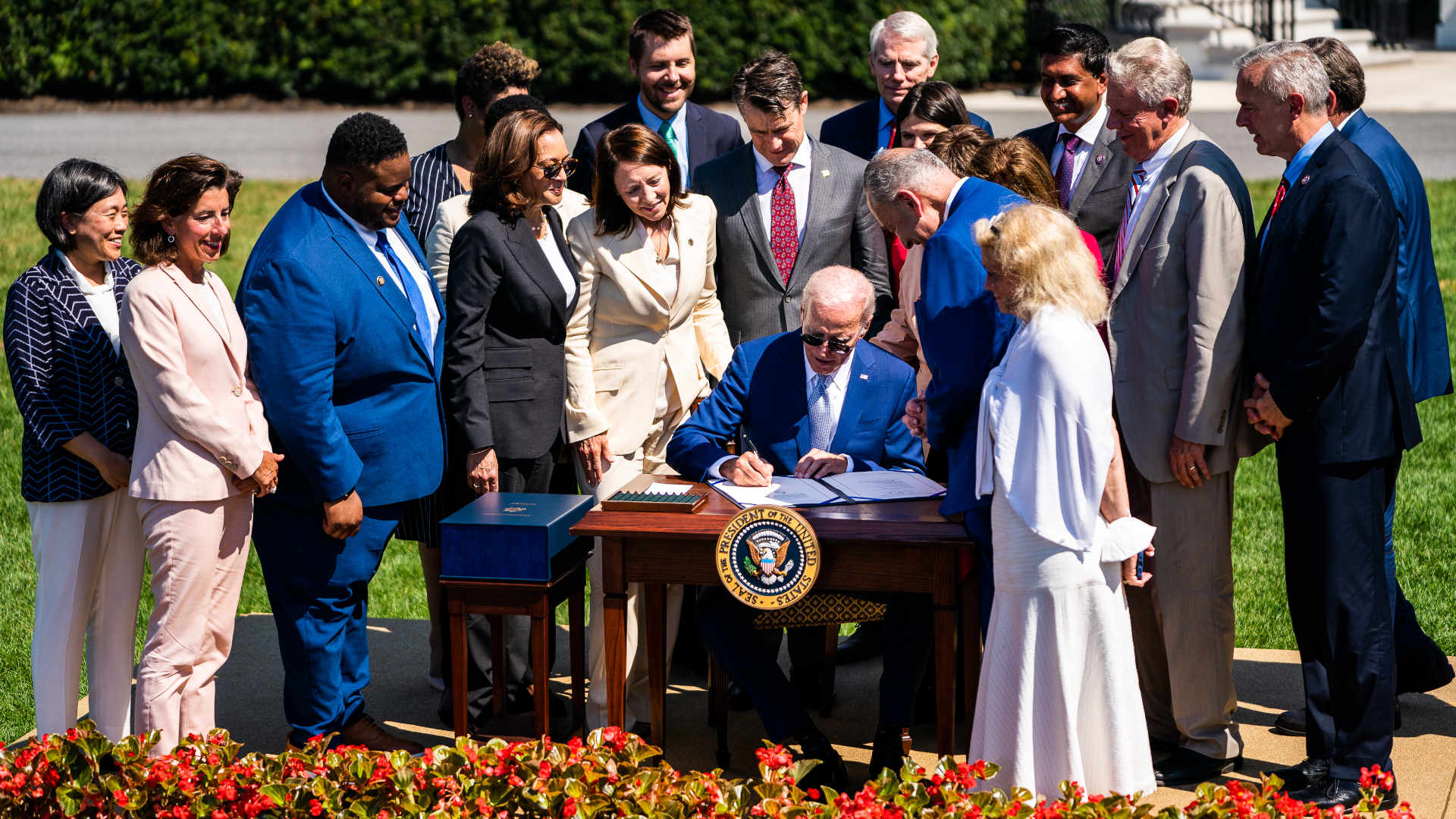Can the CHIPS Act Help Curb Harassment in Academia?
Buried in the $280 billion CHIPS and Science Act — a sprawling bill signed into law by U.S. President Joe Biden in late August and primarily aimed at increasing U.S. production of semiconductors and boosting other areas of research and innovation — is a provision that promises new attention to a longstanding problem: a $32.5 million funding pot for research into preventing and handling harassment in academia.
Despite a small amount of media attention, prior to interviews with Undark, some experts in sexual and gender-based harassment in academia hadn’t even heard about it. But in a chronically underfunded field, researchers said, the legislation has the potential to be groundbreaking. “The importance of these pieces of the law cannot be overstated,” wrote Lilia Cortina, a professor of psychology and women’s and gender studies at the University of Michigan, in an email to Undark.
The new funding in the CHIPS Act (the acronym stands for “Creating Helpful Incentives to Produce Semiconductors”) aims to support evidence-based strategies for preventing harassment in higher education or nonprofit institutions and, when it does occur, reduce its impact. The act directs the National Science Foundation and the National Academy of Sciences to create new standards of conduct for scientists and to follow up on a key 2018 NAS report on harassment.
The bill also aims to steer research dollars away from known harassers by establishing an interagency working group that will develop guidelines for institutions to report complaints, investigations, and administrative action against those who receive federal research funding. The bill also designates the NSF to award research funding to scientists studying sexual and gender-based harassment in academia.
“This bill is very important,” said Lior Brimberg an assistant professor of molecular medicine and co-president of Advancing Women in Science and Medicine, a program at the Feinstein Institutes for Medical Research. When it comes to academia, she added, “It sets a tone that sexual misconduct or any hostile working conditions will not be tolerated.”
Pressure to address harassment in academia has been building for years, fueled by revelations of long-running misconduct at some of the country’s premier scientific institutions. In 2016, for instance, a professor named Jason Lieb, who’d received millions of federal dollars, resigned from the University of Chicago after the school recommended that he be fired for sexual harassment and assault. In 2017, Science reported a series of disturbing allegations against Antarctic geologist David Marchant of Boston University. According to the school’s investigation, Marchant, who was ultimately fired, taunted and degraded at least one student during a field expedition.
A pivotal moment came with the 2018 NAS report. “That 2018 report has been like our Bible,” said Melissa Cronin, director of Building a Better Fieldwork Future, a training initiative aimed at preventing sexual harassment and assault.
“Having the National Academies sort of spotlight the issue as a major problem in science — not just a gender problem or women’s problem, but actually a scientific problem — was a really, really big deal,” she later added.
That report, cited in the CHIPS and Science Act, highlighted that the prevalence of harassment in academia is higher than in several other workplaces. It included an oft-cited statistic from a 2003 analysis that found that more than half of women in academia reported that they have experienced sexual or gender-based harassment; out of the military, private sector, and government, only those in the military said they experienced harassment more often.
The NAS report also emphasized that while harassment can include inappropriate sexual and romantic propositions, academics are more likely to experience gender-based harassment, such as derogatory jokes, suggestions that women do not belong in science, and claims that timid men won’t succeed in the field.
“The cumulative effect of sexual harassment is a significant and costly loss of talent in academic science, engineering, and medicine,” the NAS authors wrote, “which has consequences for advancing the nation’s economic and social well-being and its overall public health.”
Although the NSF declined to provide details on its plans, Mike England, an NSF media officer, told Undark via email: “NSF looks forward to participating in the interagency working group and to sharing current and developing policies related to preventing sexual and other forms of harassment. These include awardee reporting requirements, conference policy requirements, and practices to better address harassment at field sites.”
Some researchers also told Undark that the $32.5 million CHIPS funding has the potential to make big changes. “NSF has never collected national data on this topic,” wrote Cortina, the Michigan professor, who also served on the NAS committee that wrote the 2018 report, in an email to Undark. “Principal investigators found to have committed egregious sexual harassment have never been at risk of losing their federal funding. CHIPS will change all this.”
Other researchers expressed hope that the new funding will support research to address several key questions in the field.
First, researchers want to identify the most important risk factors for sexual harassment and assault. Although the 2018 NAS report identified some risk factors, such as a male-dominated workplace, according to Cronin, “we’ve only scratched the surface.”
“What should we work on first?” she added. “What should we prioritize?”
Second, researchers are keen to learn how best to wield and expand sexual harassment training. Cronin and Erika Marín-Spiotta, a geologist at the University of Wisconsin Madison, and their colleagues have separately been developing and offering trainings to address sexual and gender-based harassment in scientific fieldwork since 2018 and 2017 respectively. Both say that demand for such trainings is beyond what the programs can meet. But, it’s not always easy to tell how well they work. Several scientists said they hope the CHIPS funding will help support evaluations of trainings and other interventions.
Training isn’t necessarily enough, some experts say. When the 2018 NAS report came out, Marín-Spiotta says it highlighted a lot of strategies that don’t make workplaces safer, such as focusing on Title IX compliance with or one-size-fits-all online sexual harassment workshops. Cortina said that “organizations simply adopt an intuitively appealing training product” and then rely on completion, such as the proportion of employees trained, “as a metric of success.” A better approach, she added, would be to collect data on whether an intervention works or has unintended negative consequences, like reinforcing biases.
And finally, researchers would like to use the CHIPS funding to shift the focus on harassment reform from managing individual harassers to changing the broader research culture, In order to do so, said Jacky Jennings, an epidemiologist at the Johns Hopkins School of Medicine who co-authored a 2022 study on sexual harassment in the sciences, researchers need to examine “methods to cultivate cultures of respect and disincentivize, curtail, and confront disrespect.” According to Alexandra Zelin, an industrial-organizational psychologist who studies sexual harassment at the University of Tennessee Chattanooga, focusing on what everyone can do as a team to improve culture is a good strategy. “If you make it a culture change, something everyone’s responsible for, you’re not just putting blame on x particular group,” she said. “That’s going to be really important.”
One of the goals stated in the bill is to research alternatives to the hierarchical structure of academia. Several experts say these power dynamics contribute to harassment — and harm people who report misconduct. “The environment is one in which junior faculty are heavily reliant on mentorship and recommendations from more senior academics for advancement, and diversity (defined broadly) is limited in the upper ranks of academia,” said Jennings. “This type of environment lends itself to vulnerability and predation.”
Not many people are willing to risk all that in order to report sexual misconduct. The NAS report cited research that found only 25 percent of people who have experienced harassment took any kind of formal action, such as filing a complaint. Even the woman that Boston University determined Marchant harassed waited years to report the Antarctica fieldwork abuse — after she moved across the country and received tenure at another institution. “So many people are afraid to say something because we have seen people’s careers essentially be destroyed,” said Marín-Spiotta.
“We do a really, really poor job of protecting people from retaliation,” she continued. Future research, she added, may identify ways to mitigate the harm of the processes of reporting and investigating misconduct.
People who experience sexual harassment aren’t the only ones who suffer retaliation. It also happens to academics who research harassment, Zelin said, and it will be important to keep them safe. There is “backlash that comes along with doing this sort of work,” she added, which makes researchers targets for doxing, or publishing personal address and contact information to encourage harassment.
Most important, Zelin said, is that efforts to prevent harassment and misconduct have to go beyond research. Trainings or pushes for cultural shifts should also be matched with policy change, “because just having a ‘don’t do it you’ll get a slap on the wrist’ clearly hasn’t stopped anything in decades.”
Emma Yasinski is a freelance science journalist whose work has been published in The Scientist, Discover Magazine, and Kaiser Health News, among other publications.












Comments are automatically closed one year after article publication. Archived comments are below.
thank you Yasinki, Hendricks family